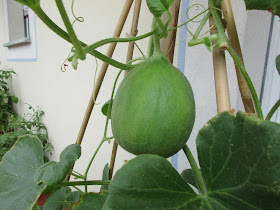Ieri pomeriggio ho raccolto il sesto e ultimo Barattiere. Almeno credo. La pianta sembra ancora vitale, anche se di nuovi frutti non c'è traccia. I caroselli spesso vanno in riposo vegetativo per poi produrre ancora. Se non dovesse succedere in questo caso, poco male: il Barattiere è il meno prolifico tra tutti i caroselli (anche se sarebbe meglio parlare di melone) e sei frutti sono un grande risultato.
 |
| (1) |
Ho preferito raccoglierlo un po' più grosso dei precedenti cinque. Pesava 618 grammi ed è stato il migliore per gusto e morbidezza della polpa.
 |
| (2) |
 |
| (3) |
THE LAST BARATTIERE?
Yesterday afternoon I picked the sixth and last Barattiere. Well, actually, I'm not sure about that. The vine seems to be still vital, even though there's no trace of new fruits. Carosellos have often a vegetative break, but later on they start to produce again. If it shouldn't happen in this case, nothing bad: the Barattiere is the least productive of all carosellos (even if it would be better call it a melon) and six fruits is an amazing achievement.
I preferred to harvest it a little bigger than the previous five. It weighed 618 grams and it was the best for taste and pulp smoothness.













































